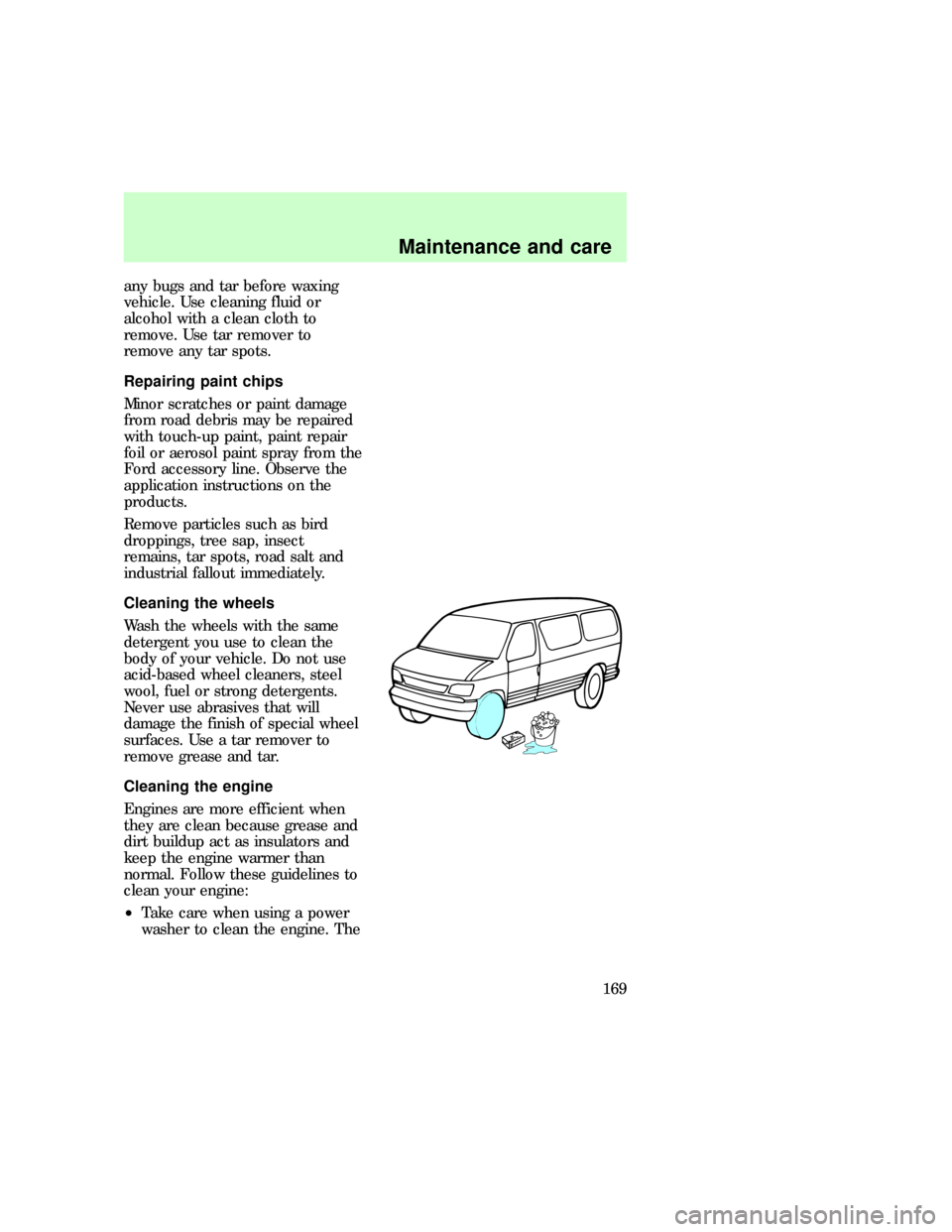Page 129 of 192
ENGINE COMPARTMENT
COMPONENTS
1. Windshield washer fluid
reservoir
2. Engine oil filler
3. Automatic transmission fluid
dipstick
4. Air cleaner
5. Engine oil dipstick
6. Power steering fluid reservoir
7. Brake master cylinder
8. Engine coolant recovery
reservoir
9. Battery
91234
5
6
7
8
com_check-add_oil.01
Maintenance and care
129
Page 135 of 192
If you use a brake fluid
that is not DOT 3, you will
cause permanent damage to your
brakes.
Do not let the reservoir for
the master cylinder run
dry. This may cause the brakes
to fail.
WASHER FLUID
Use specially formulated
windshield washer fluid rather
than plain water, because specially
formulated washer fluids contain
additives that dissolve road grime.
Washer fluids containing an
appropriate antifreeze such as
methanol should be used in
freezing weather (temperatures
below 0ÉC [32ÉF]). State or local
regulations on volatile organic
compounds may restrict the use of
methanol, a common type of
antifreeze. Use a non-methanol
antifreeze to provide cold weather
protection only if the fluid does
not damage the paint finish, wiper
blades or washer system.
eco_washer_fluid
eco_adding_washer_fluid
Maintenance and care
135
Page 136 of 192
Adding washer fluid
The vehicle's windshield washer
reservoir is located on the
passenger side of the engine
compartment. If fluid needs to be
added to the reservoir:
²Lift the windshield reservoir
cover.
²Add enough washer fluid to fill
the reservoir.
CHECKING AND ADDING
ENGINE COOLANT
Check the level of the coolant in
the reservoir at least once a
month. Be sure to read and
understandPrecautions when
servicing your vehiclein this
chapter.
If the engine coolant has not been
checked for a long period of time,
the engine coolant reservoir may
eventually empty. If this occurs,
add engine coolant to the coolant
reservoir. For more information on
engine coolant maintenance, refer
toAdding engine coolantin this
chapter.
MAX FILL
MIN FILL
com_checking-adding_coolant.01
Maintenance and care
136
Page 137 of 192

Automotive fluids are not
interchangeable; do not use engine
coolant, antifreeze or windshield
washer fluid outside of its specified
function and vehicle location.
When adding engine coolant
Ford recommends Ford Premium
Cooling System Fluid, which is an
optimized formula that will protect
all metals and rubber elastomers
used in Ford engines for four years
or 80,000 km (50,000 miles).
It is neither necessary nor
recommended to use supplemental
coolant additives in your
gasoline-powered vehicle. These
additives may harm your engine
cooling system.
When you change or add engine
coolant, it is important to maintain
engine coolant concentration
between 40% (-24ÉC [-11ÉF]) and
60% (-52ÉC [-62ÉF]), depending on
your local climate conditions.
A coolant concentration below 40%
will result in a loss of freeze
protection. A concentration above
60% may cause the engine to
overheat on a warm day.
Refer toLubricant specifications
in theSpecifications and
capacitieschapter. Use only a
premium nationally-recognized
brand name engine coolant or
equivalent.
Always dispose of used
automotive fluids in a responsible
manner. Follow your community's
com_adding_coolant.01
Maintenance and care
137
Page 169 of 192

any bugs and tar before waxing
vehicle. Use cleaning fluid or
alcohol with a clean cloth to
remove. Use tar remover to
remove any tar spots.
Repairing paint chips
Minor scratches or paint damage
from road debris may be repaired
with touch-up paint, paint repair
foil or aerosol paint spray from the
Ford accessory line. Observe the
application instructions on the
products.
Remove particles such as bird
droppings, tree sap, insect
remains, tar spots, road salt and
industrial fallout immediately.
Cleaning the wheels
Wash the wheels with the same
detergent you use to clean the
body of your vehicle. Do not use
acid-based wheel cleaners, steel
wool, fuel or strong detergents.
Never use abrasives that will
damage the finish of special wheel
surfaces. Use a tar remover to
remove grease and tar.
Cleaning the engine
Engines are more efficient when
they are clean because grease and
dirt buildup act as insulators and
keep the engine warmer than
normal. Follow these guidelines to
clean your engine:
²Take care when using a power
washer to clean the engine. The
com_repairing_chips
com_wheels_cleaning.01
com_engine_cleaning.01
Maintenance and care
169
Page 175 of 192
Item Ford part name Ford part
numberFord
specification
Engine coolant Ford Premium
Cooling System
FluidE2FZ-19549-AA ESE-M97B44-A
Engine oil
(gasoline)Motorcraft
5W-30 Super
Premium Motor
OilXO-5W30-QSP WSS-M2C153-F
with API
certification
mark
Engine oil
(diesel)Consult separate diesel engine owner's guide
supplement
Hinges, latches
and striker
platesMulti-Purpose
GreaseD7AZ-19584-AA
or
D0AZ-19584-AAESR-M1C159-A
and
ESB-M1C93-B
Lock cylinders Penetrating
LubricantE8AZ-19501-B Ð
Power steering
reservoirMotorcraft
MERCONT
Automatic
Transmission
FluidXT-2-QDX MERCON
Automatic
transmissionMotorcraft
MERCONT
Automatic
Transmission
FluidXT-2-QDX MERCON
Windshield
washer fluid
reservoirUltra-Clear
Windshield
Washer
ConcentrateC9AZ-19550-AC
or BCESR-M17P5-A
Disc brake
caliper railsSilicone Brake
Caliper and
Dielectric
compoundD7AZ-19A331-A
WA-10ESE-M1C171-A
Capacities and specifications
175
Page 185 of 192

checking the pressure ............153
replacing ...........................116,155
rotating ....................................155
snow tires and chains ............156
spare tire .................................112
tire grades ...............................151
treadwear ................................151
Towing your vehicle .................123
Trailer towing ..............................94
safety chains .............................96
tips .............................................97
trailer brakes .............................96
trailer lamps ..............................96
Transmission
automatic operation .................83
fluid, checking and adding
(automatic) .............................141
Trip odometer .............................14Turn signal
indicator lights ..........................10
Vehicle Identification Number
(VIN) ..........................................181
Ventilating your vehicle .............79
Voltmeter (see Battery voltage
gauge) ..........................................13
Warning chimes ...........................11
headlamps on ............................11
key in ignition ...........................11
safety belt .................................11
Warning lights (see Lights) .........8
Washer fluid ..............................135
Windshield washer fluid and
wipers ........................................149
checking and replacing wiper
blades ......................................150
operation ...................................27
Index
185